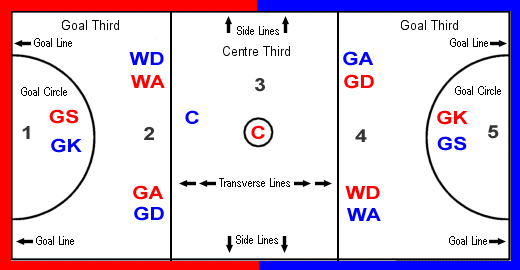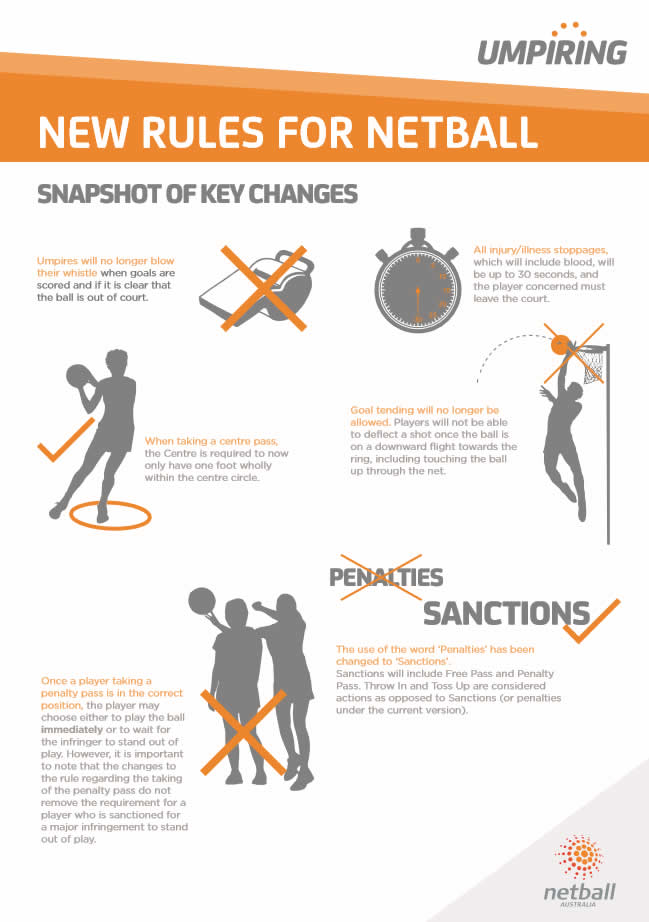Players
A netball team consists of up to 12 players with 7 players allowed on court at any one time. A team may take the court with a minimum of 5 players.
Netball Court showing starting positions for a centre pass

Playing positions & court areas
| Position | Responsibilities | Court Area |
| GS | To score goals and to work in and around the circle with the GA | 1 & 2 |
| GA | To feed and work with GS and to score goals | 1, 2 & 3 |
| WA | To feed the circle players giving them shooting opportunities | 2 & 3 |
| C | To take the Centre Pass and to link the defence and the attack | 2, 3 & 4 |
| WD | To look for interceptions and to prevent the WA from feeding the circle | 3 & 4 |
| GD | To win the ball and reduce the effectiveness of the GA | 3, 4 & 5 |
| GK | To work with the GD and to prevent the GS from scoring goals | 4 & 5 |
Playing the Game
Centre passes are taken alternately by the Centre of each team, after each goal is scored and at the start of each quarter. Each team endeavours to pass the ball to down to their goal circle and score goals. The team with the most goals at the end of the playing time wins the game.
Centre Pass
Before the whistle all players must start in the goal thirds except the two Centres. The Centre with the ball must be wholly within the Centre Circle and must obey the footwork rule after the whistle has been blown. The opposing Centre stands anywhere within the Centre Third and is free to move.
After the whistle the Centre pass must be caught or touched by a player standing in or landing wholly within the Centre third.
Scoring a Goal
Only GS or GA can score – they must be completely within the goal circle when the ball is received in order to shoot for goal. A goal is scored when the ball passes over and completely through the goal ring.
Playing Time
A game consists of 4 x 15 minute quarters with an interval of 3 minutes between the first and second and third and fourth quarters and a 5 minute half time interval. There is up to 2 minutes of time allowed for each injury.
Umpires
Two umpires have control of the game and their decisions are final. When rules of the game are broken the penalties awarded by the umpires are free pass, penalty pass (or penalty pass or shot), throw in, toss up.
Minor Infringements – Free Pass
Breaking the following rules will result in a FREE PASS being awarded to the opposing team. When a FREE PASS is awarded to a team it may be taken by any player from that team allowed in that area, as soon as they are in position. (A player may not shoot from a free pass in the goal circle).
Offside
Player moving out of own area, with or without ball (on a line counts as within either area).
Breaking at the Centre Pass
A player moving into the Centre third before the whistle is blown for the Centre pass.
Playing the Ball
- A player who has caught or the ball shall play it or shoot for goal within three seconds
- A player may bounce or bat the ball once to gain control
- Once released, the ball must next be touched by another player
- There must be room for a third player between hands of thrower and catcher
- A player on the ground must stand up before playing ball
Passing Distance
At the moment the ball is passed there must be room for a third player between hands of thrower and catcher.
Over a Third
Ball may not be thrown over a complete third without being touched or caught by a player wholly within that third.
Footwork
Having caught the ball, a player may land or stand on:
One foot – while the landing foot remains grounded, the second foot may be moved anywhere any number of times, pivoting on the landing foot if desired. Once the landing foot is lifted, it must not be re-grounded until the ball is released.
Two feet (simultaneously) – once one foot is moved, the other is considered to be the landing foot, as above. Hopping or dragging the landing foot is not allowed.
Major Infringements – Penalty Pass
Breaking the following rules will result in a PENALTY PASS or PENALTY PASS OR SHOT being awarded to the opposing team.
A PENALTY PASS (or PENALTY PASS/ PENALTY SHOT if in the goal circle) is awareded where the infringement occurred. The offending player must stand out of play beside the thrower until the pass or shot has been taken. Any opposing player allowed in that area may take the penalty.
Obstruction
Player with ball: the nearer foot of the defender must be 0.9m (3ft) feet from the landing foot of the player with the ball, or the spot where the first foot had landed if one has been lifted. The defender may jump to intercept or defend the ball from this 0.9m (3ft) feet distance
Player without ball: the defender may be close, but not touching, providing that no effort is made to intercept or defend the ball and there is no interference with the opponents throwing or shooting action. Arms must be in a natural position, not outstretched, and no other part of the body or legs may be used to hamper an opponent.
Intimidation: of any kind, is classed as obstruction
A standing player is not compelled to move to allow an opponent a free run, but dangerous play must be discouraged, e.g. moving into the landing space of a player already in the air or stepping late into the path of a moving player.
Contact
No player may contact an opponent, either accidentally or deliberately, in such a way that interferes with the play of that opponent or causes contact to occur.
Out of Court – Throw in
A THROW IN is awarded to the opposing team of the player who last had contact with the ball or who received the ball whilst in contact with anything outside the court. Ball is out of court when it contacts anything outside the court area (except the goalpost). The ball is returned into play by a Throw-In taken from a point outside the court where the ball crossed the line. The player stands with foot close to the line, and the ball must be thrown onto the court within three seconds.
Toss Up
This is administered for all simultaneous infringements. The two players stand facing each other at their own shooting ends with hands by their sides and the umpire flicks the ball upwards not more than 600mm (2ft) in the air as the whistle is blown.
2016 Rule Changes
Here is an overview of the changes, download the full brochure for more information.








